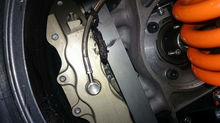Fuel Systems
- Alex Harrington
- Oct 17, 2015
- 3 min read
This week’s lecture was on fuelling systems and the differences on systems between road cars, track cars, rally cars and diesel cars.
The fuel system starts with the fuel cell where we have multiple low pressure pumps that will pump the fuel from each cornet of the cell when the car is accelerating, decelerating or cornering the fuel will flow around in the cell so having multiple pumps ensures we get a constant feed of fuel to the engine.
On the end of the pumps where the fuel is initially picked up we have a piece of material that strains out larger sediment from the fuel, the fuel then travels to the second pump in the system, a high pressure pump, this is where the fuel is pressurised to the set pressure the system should be running (in some systems the order of the pumps and filters can vary).
The next component on the system is the main fuel filter, this is to remove any small pieces of debris in the fuel, and the filter uses very thin strips of paper to filter the fuel. From the filter the fuel is now sent to the fuel rail (on a multipoint injection system) this is where the injectors are attached and the fuel is injected into the inlet port. The fuel rail, if it is a return system, will have a pressure valve on the end of the rail and a return line to the fuel tank. The return valve will operate off a diaphragm and a spring that is set so that at a certain pressure the diaphragm deforms and the spring compresses allowing fuel to flow through but as soon as the pressure had decreased to a certain point the spring will push back to its original place and the diaphragm will go back to its original shape and stop fuel returning to the rail and keeps the pressure in the rail for the injectors.
The injectors themselves are very simple, they use a solenoid to release the pressure and fire a certain amount of fuel into the inlet port on the engine. The amount of fuel injected is down to the injector duration and the setup of the injectors, some inject simultaneously so all the injectors’ fire at the same time (usually on V engines where there are two rails that trigger the injectors simultaneously on either rail) or they can inject individually of each other when the ECU sends a voltage to them and this charges the coil in the solenoid and temporarily magnetises the plunger and the fuel flows past then the ECU stops the voltage to the injector and there is a return spring that pushed the plunger back into place thus stopping the flow of fuel.
The ECU controls the operation of the injectors buy taking incoming sensor data and comparing this data to its lookup tables and then from this the ECU can control actuators such as injectors to make the engine run differently. For example if the driver goes from low load cruising in a car to accelerating hard the ECU will take data from the throttle position sensor, the air mass meter, the coolant temperature sensor and the knock sensor and will increase the injector duration to give a richer fuel mixture and it will be also keeping the ignition timing as advanced as possible. When the driver takes his foot off the accelerator the engine will drop in revs and on the overrun sometimes the injectors may not even need to fire as the engine isn’t required to make power, the fuel pressure will build in the fuel rail now because there is no pressure being relived into the cylinders so the return valve will now be in operation and when the car returns to cruising and the injectors are being used the fuel pressure will normalise and the return valve can close.















Comments